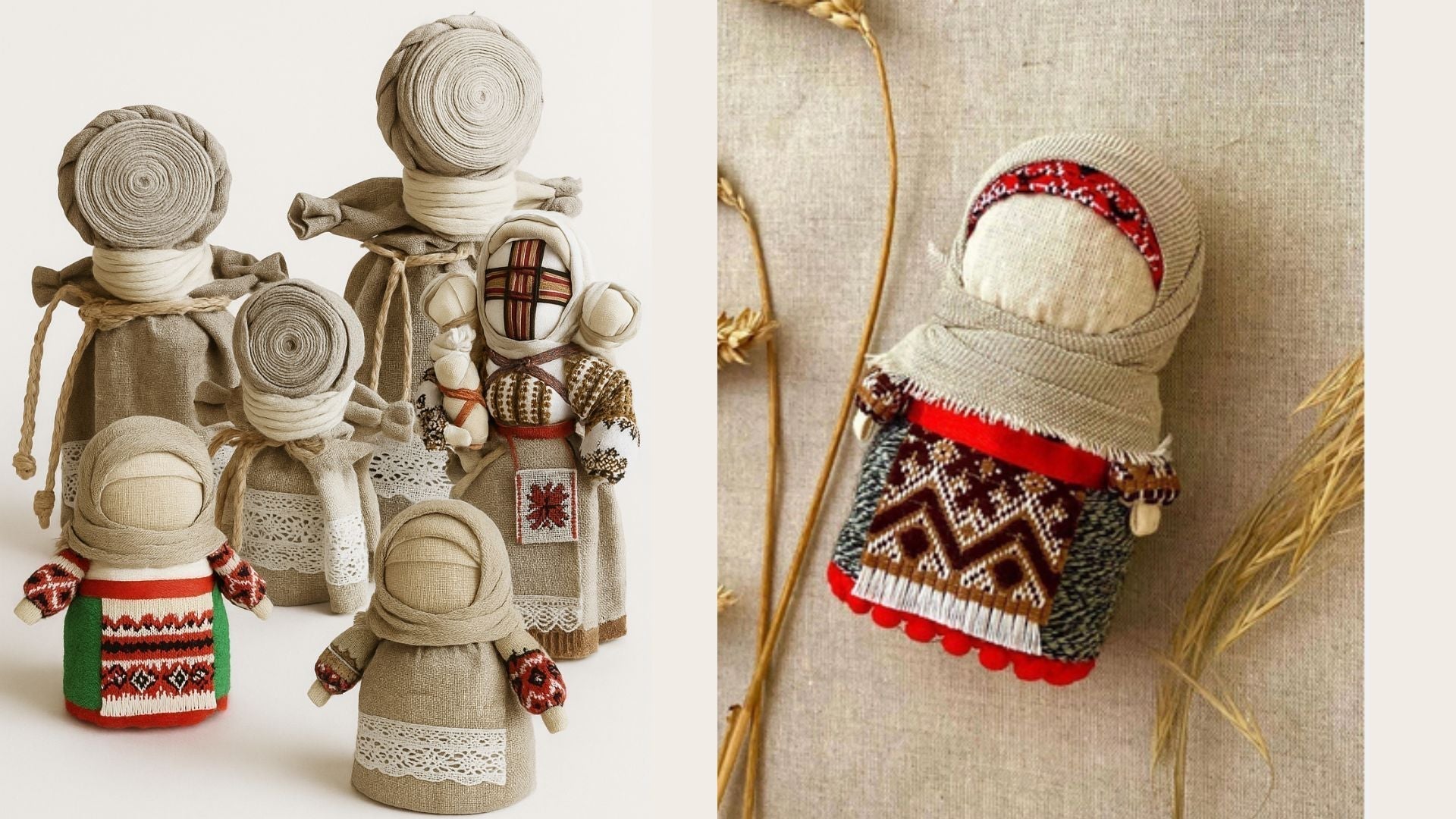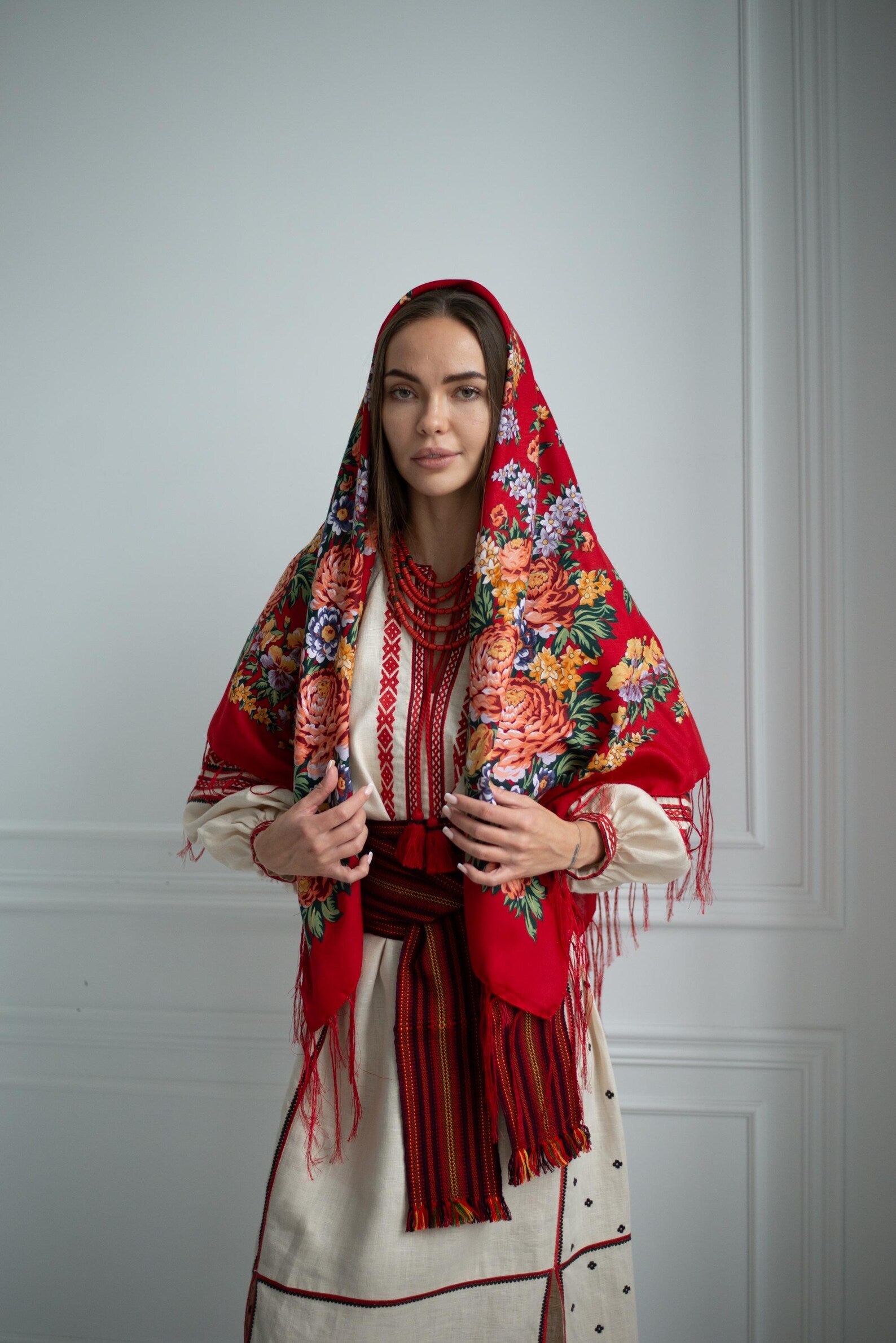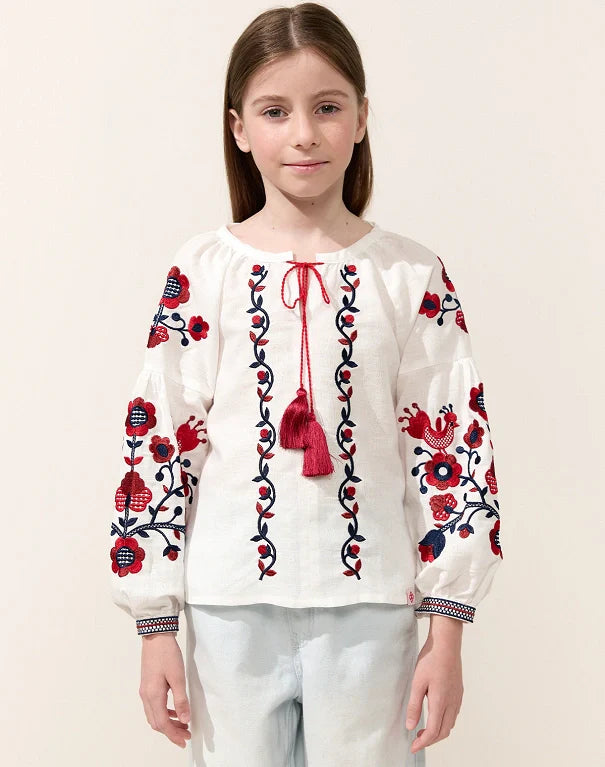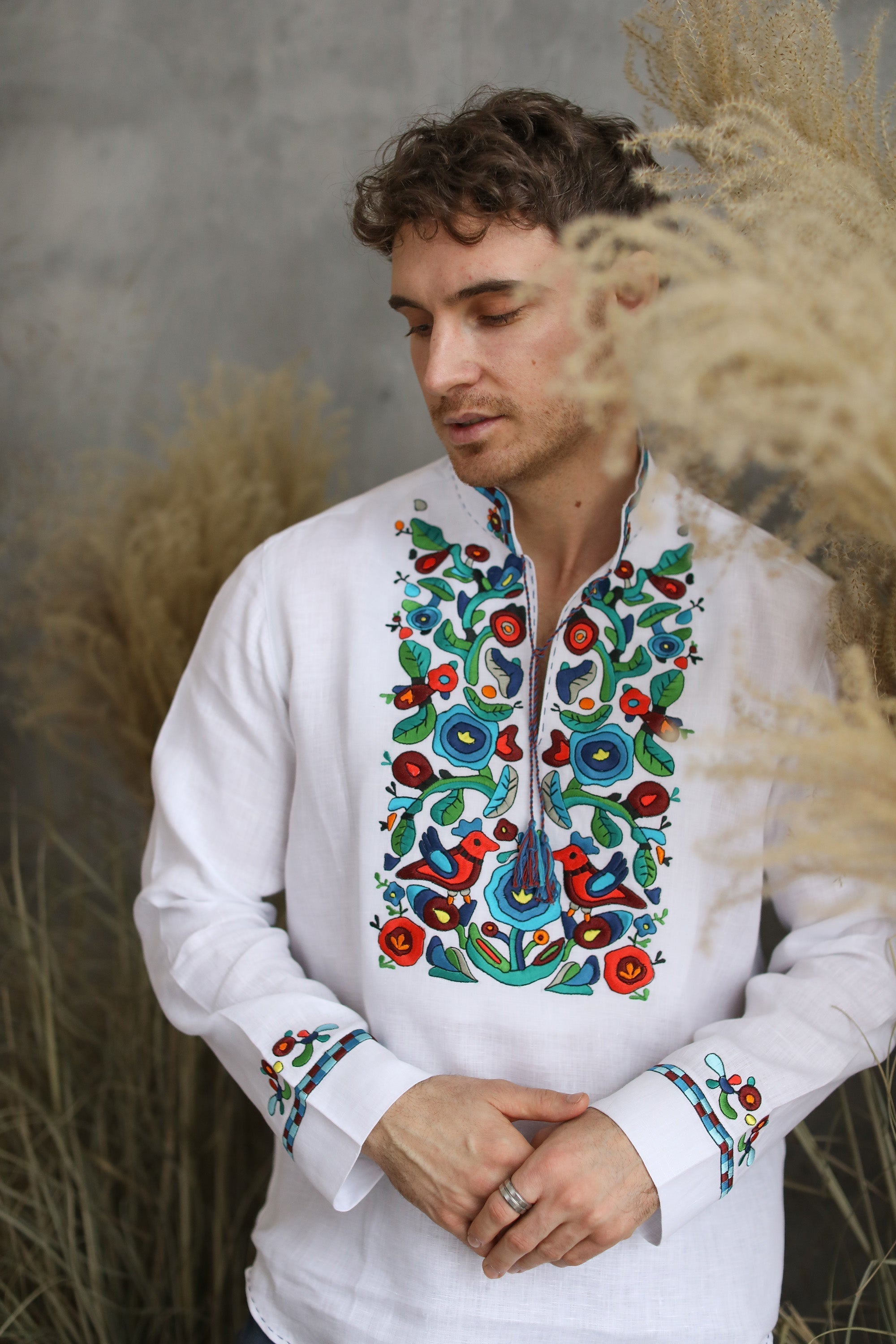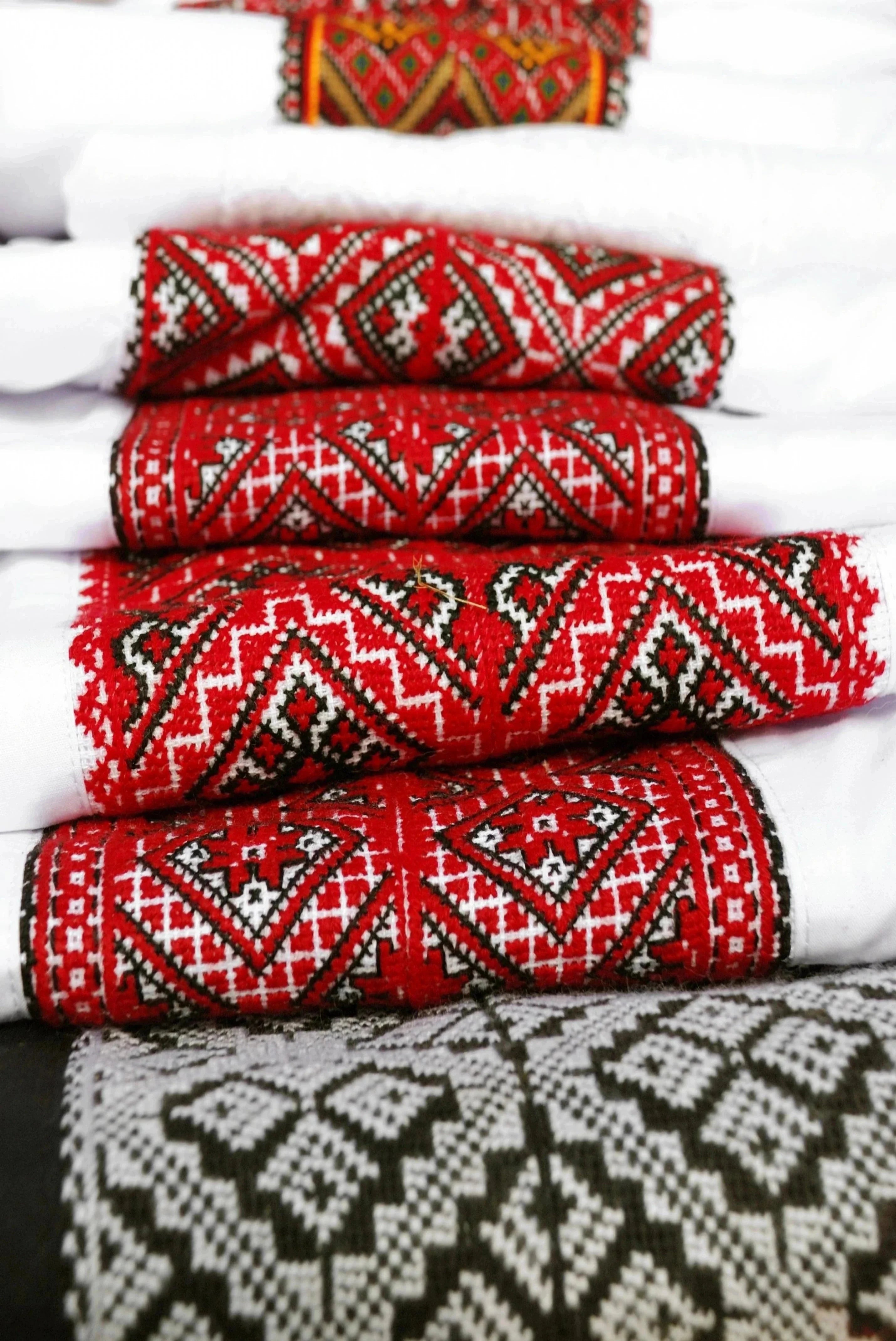
The Story Woven in Threads: A Journey Through Ukrainian Ethnic Clothing
>> White Wedding Linen Dress With Ukrainian Vyshyvanka Red Embroidery in our store
Whereas song is the soul of a people, and dance is its character, folk costume is its outward appearance, attractive and bright, exquisite and fastidious. Equally with language, traditional dresses are one of the most important ethnic characteristics. A homespun linen white shirt decorated with embroidery accompanied Ukrainians from birth to death.
Considering the diversity of natural and landscape zones, and the peculiarity of economic and cultural development of Ukrainian lands, the main four regional complexes have been formed in Ukrainian clothing - those of Polissia, Forest-Steppe, Steppe, and Carpathia - and their numerous sub-regional variants.
Ukrainian Traditional Clothing: History, Symbols, and Global Impact
Traditional clothing, Ukrainian Embroidery a profound connection to nature and the cycles of life. The motifs embroidered on garments often draw inspiration from plants, animals, and celestial bodies, reflecting the wearer’s harmony with the environment and spiritual world. These symbols serve as protective talismans, invoking health, prosperity, and strength.
Throughout history, traditional attire has been an essential element in rites of passage — from birth and weddings to funerals. Each event features specific garments and embroidery patterns that communicate social status, family heritage, and community belonging. This encoded visual language helped preserve cultural identity even during times of foreign domination and upheaval.

Ukrainian photographer Anatoliy Pavlovsky began taking these photographs in 1909. They show what Poltava region was like at that time. The photographer managed to capture the diversity of the traditional clothing worn by the women of Poltava, most of which can now only be studied in photographs.
In recent decades, Ukrainian ethnic dress has transcended its regional origins, gaining recognition on international fashion stages and cultural events. The history of vyshyvanka, in particular, has become a global icon of resilience and pride, worn by people worldwide as a statement of solidarity with Ukraine’s heritage and ongoing struggle for freedom.
Ancient Beginnings: The Scythian Echo
Traditional Ukrainian clothing has deep historical roots, stretching back to the Trypillian culture. The people of this ancient civilization adorned their garments with intricate patterns, which were not merely decorative but held symbolic meaning, often serving as protective charms, similar to talismans in various ancient cultures. This tradition of embroidering clothing with meaningful designs highlights Ukraine’s rich cultural legacy.
The most iconic item is the vyshyvanka, an embroidered shirt worn by both men and women, often on holidays and national celebrations.

Ukrainian family – mother and her 3 daughters – in folk clothes and Cherkasy region, central Ukraine, the early 20th century.
Medieval Ukraine and the Rise of the Vyshyvanka
During the time of Kyivan Rus (10th–13th centuries), embroidery became a spiritual practice. Specific patterns and colors were placed strategically on garments to protect the wearer. Embroidery was believed to offer spiritual protection — a thread-bound prayer against evil. Men's shirts were embroidered around the collar, while women's garments featured intricate patterns on sleeves, hems, and necklines. For example:
- Collars and cuffs were embroidered to “seal” energy.
- Women’s shirts featured protective motifs on sleeves and hems.
- Embroidery was passed down from mothers to daughters as a sacred tradition.



Traditional Wardrobe: Key Elements
Traditional Ukrainian clothing is more than just fabric and thread—it's a narrative of a people's identity, craftsmanship, and spiritual heritage. This blog post explores the ethnographic diversity of Ukrainian garments across multiple regions and how they reflect Ukraine’s historical and cultural evolution.
|
Vyshyvanka (shirt) |
The centerpiece — a white linen shirt adorned with embroidery |

|
Plakhta |
A traditional woven skirt worn by women |

|
Kersetka |
A festive sleeveless jacket |
|
Wreath |
Women’s headdress, head decoration |
>> Red Floral Headdress With The Colored Ribbons in our store
>> Colorful Floral Crown With 10 Ribbons in our store

|
Kuzhukh / Svita |
Outer garments (kuzhukh for nobility, svita for peasants) |
|
Krayka / Zapaska |
Krayka (mandrel, elastic) - a rather narrow belt that held the hip unstitched and later stitched clothing |
>>> Ukrainian Krajka Hutsul in our store
Cossack Era (16th–18th Centuries): The Dream of Freedom
During the Cossack era, clothing not only served practical purposes but also became a powerful symbol of identity and defiance against foreign rule. The distinctive wide trousers, known as sharovary, allowed freedom of movement essential for horseback riding and combat, embodying the warrior spirit of the Cossacks. Brightly colored sashes and embroidered coats highlighted social status and regional affiliation, making attire a statement of both personal and collective pride.
The fusion of Eastern influences from the Ottoman Empire and Western European styles enriched Cossack fashion, creating a unique aesthetic that set Ukrainians apart from their neighbors. This blend symbolized the cultural crossroads where Ukraine stood—a land fighting to preserve its autonomy amid powerful empires. Garments were often adorned with intricate embroidery and decorative elements that conveyed courage, freedom, and resilience.

Young bride and her bridesmaids in traditional costumes. Poltava region, central Ukraine, 1955. They’re belted with hand-woven ceremonial towels, as old wedding tradition dictated
Moreover, clothing during this period played a significant role in unifying the Cossack community. Wearing traditional dress at gatherings, military campaigns, and ceremonies reinforced a shared sense of purpose and belonging. Through their attire, the Cossacks visually proclaimed their dream of freedom, inspiring generations that followed to cherish and protect Ukrainian heritage.

In addition to corsets, Anatoly Pavlovsky managed to record a variety of drapes and skirts. The skirts were made of thin fabrics, were quite wide, and were decorated with additional frills.
19th to Early 20th Century: Clothing as National Identity
During this era, the rapid social and political changes sweeping through Ukraine and Europe heightened the importance of clothing as a marker of identity. Traditional garments became a visible assertion of Ukrainian uniqueness amid pressures of assimilation by dominant empires. Folk festivals and national gatherings saw a deliberate revival of regional costumes, each stitch reinforcing ties to ancestral roots and collective memory.

Wedding outfits, in particular, evolved into elaborate displays of craftsmanship and symbolism. Brides wore richly embroidered dresses and sashes that told stories of fertility, protection, and family legacy. These garments were treasured heirlooms, carefully preserved and passed down through generations, becoming both personal and communal symbols of resilience and hope for the future.

Ukrainian bride and groom in traditional wedding clothing. Poltava region, central Ukraine, the early 20th century. In the past, in 1923-1930, Pryluky was the center of the Pryluky district, which was part of the Poltava province, now it belongs to the Chernihiv region.
The vyshyvanka’s role expanded beyond folk traditions to the political realm. It was worn openly during uprisings and protests as a form of peaceful resistance against foreign domination and cultural suppression. By embracing their traditional dress, Ukrainians not only celebrated their heritage but also defiantly proclaimed their right to self-determination and freedom.
Soviet Suppression and Silent Preservation
Under Soviet rule, any expressions of national identity outside the prescribed Soviet ideology were often harshly suppressed. Traditional Ukrainian clothing, especially the vyshyvanka, was labeled as a symbol of “bourgeois nationalism” and discouraged in public life. Wearing embroidered garments openly could attract unwanted attention from authorities, forcing many to conceal their cultural heritage or abandon it altogether. Ukrainian embroidery clubs, cultural associations, and churches kept the art alive, passing it on to new generations.

Despite this repression, Ukrainian families preserved their embroidery traditions in secrecy. Hand-stitched garments were carefully stored away or passed down quietly from mother to daughter, often hidden in wardrobes or boxes. These treasured pieces became more than just clothing — they were tangible links to a suppressed history and silent acts of cultural defiance that kept the spirit of Ukraine alive.

The Ukrainian diaspora also played a crucial role in preserving traditional dress during this time. Communities abroad continued to wear vyshyvankas at celebrations and church events, maintaining a visible connection to their homeland. Through these efforts, embroidery survived as a powerful symbol of resilience, identity, and hope, ready to be embraced anew after independence.
A Mosaic of Regions: Ukrainian Ethnic Styles by Territory
Ukrainian traditional dress varies greatly by region — each one a unique visual language shaped by nature, history, and folk belief.
🇺🇦 Dnieper's Region (Central Ukraine)
The geographic heart of Ukraine, including Kyiv and surrounding areas.
-
Style: Harmonious and symbolic.
-
Embroidery: Red-and-black motifs with protective solar symbols.
-
Clothing: Classic white vyshyvankas with floral themes.



🇺🇦 Poltava Region
Famed for its refined and delicate embroidery.
-
Style: Minimalist, poetic.
-
Embroidery: White-on-white or soft gray threads, lacework.
-
Mood: Whispered elegance, deeply romantic.




🇺🇦 Podolia Region
A fertile, lively region in central-western Ukraine.
-
Style: Decorative and festive.
-
Embroidery: Red and black cross-stitch, sometimes green or yellow.
-
Essence: Floral joy and geometrical harmony.

🇺🇦 Opillia
Nestled between the Carpathians and Dniester, known for rich layers.
-
Style: Earthy and textured.
-
Embroidery: Thick, expressive stitches.
-
Clothing: Wrap skirts, wool vests, embroidered aprons.

🇺🇦 Galicia (Halychyna)
Western Ukraine with strong European influences.
-
Style: Decorative and noble.
-
Embroidery: Multicolored silk threads, vertical patterns.
-
Impression: Rustic elegance meets aristocracy.


🇺🇦 Volhynia
An ancient region in northwest Ukraine.
-
Style: Restrained, sacred.
-
Embroidery: Monochrome, linear, and geometric.
-
Spirit: Ancestral strength and subtle charm.


🇺🇦 Steppe Ukraine
Southern Ukraine’s vast plains shaped its dynamic folk dress.
-
Style: Bold and vivid.
-
Embroidery: Large floral patterns with striking colors.
-
Influence: Cossack strength, warmth, and joy.

🇺🇦 Sloboda Ukraine
Northeastern Ukraine, blending frontier and Cossack traditions.
-
Style: Symbolic and martial.
-
Embroidery: Red, blue, green motifs — often sun and plant symbols.
-
Legacy: Protective dress and layered outerwear.


🪡 The numerous subregional zones of the Ukrainian territory include:
|
Region |
Color/Pattern Focus |
Clothing Description |
|
|
Volhynia |
Monochrome geometric lines |
Simple linen shirts with black-and-white geometric embroidery, paired with dark wool trousers and sashes. |
|
|
Galicia |
Silk threads, velvet, brocade |
Elegant silk vests with velvet accents, brocade skirts or coats, often with gold-thread embroidery. |
|
|
Transcarpathia |
Bright colors, mixed patterns |
Colorful embroidered blouses with floral and folk motifs, paired with layered skirts or vests in red, green, and blue. |
|
|
Podolia |
Red/black florals, geometric forms |
Vibrant blouses with red-and-black floral patterns and geometric shapes, matched with colorful aprons. |
|
|
Polissya |
Monochrome patterns, gray-white tones |
Plain gray or white linen garments with minimal monochrome stitching, paired with simple wool sashes. |
|
|
Middle Naddniprianshchyna |
White-on-white, floral lace |
Delicate white-on-white lace shirts and dresses, often with subtle floral embroidery and light sashes. |
|
|
Sivershchyna |
Multilayered ornaments, moderate colors |
Multi-embroidered vests and shirts in muted tones (blue, green), layered with decorative sashes. |
|
|
Sloboda Ukraine |
Multicolor symbols, layered outfits |
Bold multicolored symbol-embroidered coats and shirts, worn with multiple layers of protective clothing. |
|
|
Zaporizhzhia Region |
Red-yellow motifs, bold patterns |
Striking red-and-yellow embroidered coats and shirts with bold geometric patterns, paired with wide sashes and trousers. |
|
|
Donshchina |
Red-black florals, solar symbols |
Vibrant red-and-black floral shirts with solar symbols, worn with wide trousers and decorative belts. |
|
|
Prychornomoria |
Blue-white waves, simple ornaments |
Lightweight blue-and-white dresses or shirts with wave-like patterns, paired with light sashes and accessories. |
|
|
Tavria |
Bright greens, whites, geometric shapes |
|
 Female festive costume from Ternopil region of Ukraine, Chortkiv district, the early 20th century |
 Young bride’s wedding outfit from Odesa region of Ukraine, Podil district, the early 20th century |
 Women’s festive outfit from Cherkasy region of Ukraine, Cherkasy district, the early 20th century |
 Women’s festive clothing from Ivano-Frankivsk region of Ukraine, Kosiv district, village of Babyn, the early 20th century |
 Women’s festive outfit from Ivano-Frankivsk region of Ukraine, Kolomyia district, the late 19th – early 20th century |
 Female festive costume from Kyiv region of Ukraine, Fastiv district, the late 19th – early 20th century |
A Global Symbol of Freedom
From protest marches to fashion runways, the vyshyvanka has become a globally recognized emblem of Ukrainian dignity, resilience, and creativity. It appears on presidents, schoolchildren, and diaspora families alike — a garment of memory, meaning, and hope.
Ukrainian ethnic dress is a masterpiece of generations — woven with love, worn with pride, and carried into the future.
The Meaning Behind Ukrainian Embroidery
Ukrainian embroidery (vyshyvka) is a visual language full of symbolism:
-
Red: life, love, energy
-
Black: earth, stability, sorrow
-
White: purity, peace
-
Green: youth, growth
-
Geometric patterns: eternity, harmony
-
Floral motifs: femininity, fertility
-
Birds: freedom, soul, connection with ancestors
Each vyshyvanka is a story — personal, regional, and national.
Revival and Global Influence (Post-1991)
Since Ukraine’s independence in 1991, there’s been a massive revival of national dress. With the fall of the USSR, Ukrainians reclaimed their cultural identity with pride. The vyshyvanka emerged as a global symbol of dignity, unity, and freedom.
Modern Ukrainian Fashion and Vyshyvanka Revival
The vyshyvanka has become a global symbol of Ukrainian pride, often worn during:
- Vyshyvanka Day (3rd Thursday in May)
- Weddings and traditional ceremonies
- Vyshivanka for Mother's Day
- Ukrainian Vyshivanka Style
Today, Ukraine celebrates Vyshyvanka Day, when millions wear embroidered garments in a vibrant display of cultural resilience.
 Contemporary designers, from Ukraine and beyond, continue to reinterpret these ancient motifs. High fashion brands — including Dolce & Gabbana, Gucci, and Valentino — have featured Ukrainian-inspired embroidery on international runways.
Contemporary designers, from Ukraine and beyond, continue to reinterpret these ancient motifs. High fashion brands — including Dolce & Gabbana, Gucci, and Valentino — have featured Ukrainian-inspired embroidery on international runways.
>> Linen White Embroidered Dress With Embroidery in our store
Heritage Reimagined: Contemporary Fashion by NDUkraine
Today, our brand, NDUkraine, breathes new life into traditional Ukrainian clothing, combining the craftsmanship of our ancestors with a modern aesthetic. From delicately embroidered linen dresses to bold, minimalist vyshyvankas, all garments reflect a deep respect for heritage while aligning it with modern fashion. Handcrafted in Ukraine from natural fabrics, each piece not only honors regional symbolism, but also supports sustainable and ethical production.
NDUkraine’s work is an example of how traditional art can flourish in modern wardrobes, offering the world authentic yet wearable elements of Ukrainian identity.
You can also push carts of Ukrainian embroidered shirts in our store.
Why Ukrainian Traditional Clothing Matters Today
In a world searching for authenticity and cultural identity, Ukrainian ethnic fashion offers both tradition and innovation. Vyshyvanka isn’t just fashion — it’s a declaration of freedom, a wearable legacy, and a timeless celebration of beauty, nature, and ancestry.
>> White Ukrainian Vyshyvanka Blouse in our store
>> White Ukrainian Vyshyvanka Blouse in our store
🌍 Ukrainian Fashion Goes Global
Ukrainian ethnic fashion - folk dress is now recognized as part of UNESCO’s intangible cultural heritage efforts. Ethnic fashion bloggers, stylists, and artists across Europe, North America, and Asia are embracing Ukrainian designs — both in streetwear and high fashion.
Ukrainian traditional clothing is more than history — it’s a movement.
Wear a vyshyvanka, and you wear centuries of resilience, hope, and beauty.
Photos used:
- Ukrainian photographer Anatoly Pavlovsky,
- Zaporizhzhia Art Museum,
- from the collection of Olena Skrypka,
- Ivan Honchar Museum (Kyiv)
- Lviv Museum of Ethnography and Crafts,
- Lviv Museum of Folk Architecture and Life,
- Volyn Museum of Local Lore (Lutsk)







